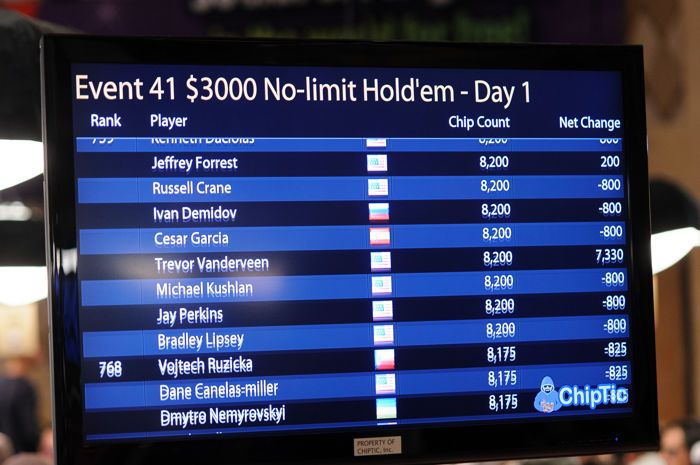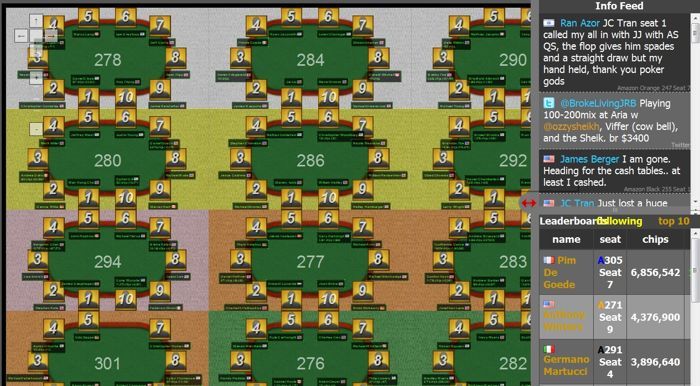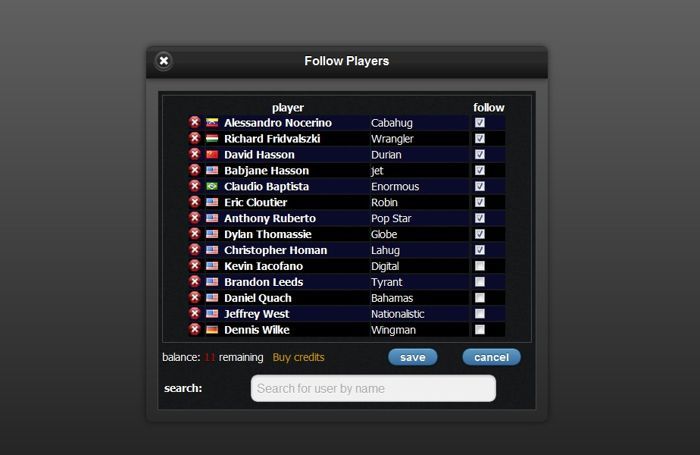At the 2012 World Series of Poker, a shiny new product received its public unveiling. Players and fans the world over were introduced to a program with revolutionary potential. It could track the chip ebbs and flows of every player in a tournament while also serving as the back end operating system to run said tournament. It promised the ability to change the way poker tournaments were followed, with players and fans interacting at the stroke of a few keys.
That product was ChipTic. And it proved to be a colossal failure.
This is the oral history of ChipTic, from those who experienced it first-hand and witnessed that failure — three former employees, two members of WSOP staff and two poker media members who watched it implode. The interviews have been edited and condensed for clarity. All titles are dated to 2012.
A One-Stop Shop for Poker Tournaments
Dan Carpenter (ChipTic operations director): I ran the DeepStack Extravaganza on day shift at the Venetian. I left Venetian in 2010 and I had moved to Austin, Texas. I got approached in April of 2011. I got a call out of the blue from a guy, John Beveridge. I remember the guy, but we weren’t close. He was a player and he owned a company called PageMail. He was a fairly well-off guy.
Doug Shrader (ChipTic employee): John was the guy with the vision. This was kind of his dream.
Dan Carpenter: He said, “You run the best tournaments, you’re nice, you’re friendly, you enforce all the rules. I would like you to be operations director for this project I’m working on.” He made me sign a [non-disclosure agreement]. He showed me basically it did everything you could think of with a tournament, right from when you register.
I agreed to do the job. We recruited [Eric Brewstein] out of Philly to be the finance guy. He kind of knew everyone at the WSOP. Very savvy business guy.
Doug Shrader: I was the first one to be brought on as one of the “fab four.” They needed me because they needed a dealer perspective to see how the dealers would react. I was brought in to oversee everything and back up Dan. Answer any question the players had, help the dealers along if they had problems. As a dealer myself, I know what it’s like to be in the box. I was there to streamline the process and help any way that I could.
“It was more or less a tournament clock, Bravo and chip tracking technology all in one.”
Dan had approached me with an opportunity. It was very vague as to what exactly it was going to entail, but I knew it was poker-related. He asked me a question: What if you could be in a poker tournament and at any time, anyone in the world could know what your chip stack is?
I said, “Is this something to do with chips?”
He said, “I can’t tell you. Do you think it would be big?”
In college, I watched every WPT, every WSOP. As a fan, I think it would be a really cool feature to be sitting at home and be on your mobile device and see how Daniel Negreanu is doing in the tournament. Immediately, I said I’m listening.
Dan Carpenter: BlackBerry gave us 900 tablets for free. They were kind of on the downswing and were trying to get their name out there a little bit. We configured them so when you registered, you got your picture taken. You bought in and when you sat down, the software knew who you were. “Dan Carpenter, Seat 4 from U.S.A. and 10,000 starting chips.” The dealer could look at me and look at the picture and see it was me. The dealer would hit a button, “receive player.” That would activate them. Whenever a player got busted out, the dealer would hit “bust player.” That would open the seat virtually in the system.
So, there was no more seat cards. The way we broke tables, we had this car battery…it was like a shopping cart with a black skirt around it. It had a car battery and it had AC ports. We could plug in a thermal printer and a laptop. You hit “bust table” and that would instantly spit out 10 seat cards and you handed them to the players. The system knew where they were going so on their new tables they’d show up grayed out and the dealer would receive them at the new table. You could break five tables in under two or three minutes. You didn’t need five floor people anymore. So it was pretty revolutionary software in that regard.
But that wasn’t even the exciting part of the software. The exciting part was the player side of things. On the player side, they were able to update all their chip counts and see a running leaderboard. There was two ways the chips could be updated: the dealer could do it but most of the content was user-generated. There was a website; you had to go to chiptic.net. You had a username and a log-in and you could update all of your chip counts on there. All of the data was saved and you could track on the back end how you did each level of the tournament. We bought 45 TVs and there were scrolling leaderboards. You could see real-time data on the screen.

Doug Shrader: There was a failsafe. Let’s say they put 11 million instead of 1.1 million. It would error out. That way, they kind of kept everything in line. It was a really cool process.
It was more or less a tournament clock, Bravo and chip tracking technology all in one. We were able to be a three-in-one opportunity for people to choose us instead of paying Bravo, and others. We were the one-stop shop. We could run everything off of our platform.
Dan Carpenter: Believe me, as someone who ran thousands of tournaments, it was amazing software.
“Damn this is gonna revolutionize poker.”
I thought, “Damn this is gonna revolutionize poker. This thing is gonna be big, it’s gonna be everywhere.” I got high-quality people to quit their jobs at Venetian to come work on this project.
Doug Shrader: I was living in Vegas at the time working in a major casino. I was a little hesitant. I didn’t want to lose my job but I also was intrigued as to the upside potential of this venture. I accepted. I signed a non-disclosure to make sure I wasn’t going to take the idea and run with it myself.

The Iowa Test Drive
After an initial plan to meet in San Diego, the WSOP Circuit at Horseshoe Council Bluffs in Iowa was chosen as the testing ground.
Doug Shrader: John had gotten in contact with the WSOP, with [tournament director] Jack Effel. He was very interested, extremely interested. He said, “If you can show us a mock that it works, we’ll implement it into the WSOP this year.” We all four flew out there and I believe the coder was there as well.
“We ran the beta test, and it failed miserably.”
Dan Carpenter: We only tested out some of the components of the system when we were there. We didn’t utilize a lot of the technology. We were just testing it out on a small scale.
Charlie Ciresi (WSOP tournament director): I was getting ready to do the Circuit in Council Bluffs. (WSOP VP of Corporate Communications) Seth Palansky gave me a call and said, “We’re gonna try to experiment with some new software. They’re gonna try to test it in a couple of tournaments.” I had no idea what it was about at that time. Jack called me and told me a little bit more about what it was gonna be. John reached out to me and just kind of talked me through what it was and what they were gonna be doing.
Doug Shrader: We ran the beta test, and it failed miserably. I think it was in a nightly tournament.
As long as you entered everything correctly to begin, everything was good. If you entered anything wrong or the table broke and you didn’t know, everything was ruined. People were busting out so quickly, we couldn’t track them. They’d break a table, and we’d be entering information and another table would break. We were trying to play catch up the whole time. I can’t remember if it crashed or it just fell behind. I think the whole system just went down.
Jack said, “You have one more chance.”
It was either the next day or the later tournament. We ran it and it ran to perfection. We knew exactly who went where beforehand. We had somebody right there with an iPad. As long as you could enter in at that moment of breaking, it was perfect. It was a matter of not letting players leave the table until their information was typed into the system. Once we realized the severity of the situation, we did everything ourselves and it worked flawlessly.
Dan Carpenter: I’ll never forget when we ran it in Iowa, all 100 people in the tournament were standing around this one TV waiting to see their name. It was a pretty neat moment.
Charlie Ciresi: It ran pretty well. Obviously, small fields in Iowa but it ran well.
“I love it. I love the idea, let’s implement it this year at the WSOP.”
I talked to John at length every day. He had a really big understanding of poker. He designed the software with some developers who were on site. They made some small tweaks here and there. Jack was there towards the end and witnessed it.
Doug Shrader: We sat down with Effel and some other high-level executives. He said, “I love it. I love the idea, let’s implement it this year at the WSOP.”
Dan Carpenter: No money exchanged hands in either direction. The way ChipTic was gonna make money was based on you as a fan sitting at home. You could log on to the software and click onto the virtual tournament room. You’d see 220 tables in the WSOP and you could follow 10 players for like $4 or something. We hadn’t come up with the pricing yet.
You could say, “I want to follow Doyle Brunson, Phil Ivey, Scotty Nguyen.” What following meant was any time they updated their chip stack it would tell you, “so and so updated their stack.” Doyle Brunson could also say on the app, “I just busted Phil Hellmuth.” That message would come up in a little chat bubble to his followers. You could click on that and respond to Doyle Brunson. That message would be relayed back to the WSOP and we had 45 TVs located around the rooms. The messages you said online at home would be fed back to the TVs, so you could communicate with the people you were following. You could link it to your Facebook and Twitter as well so it would go out to everything.

We just wanted a few dollars from each person a couple hundred times per event. Hopefully, you’d get tens of thousands of fans.
Doug Shrader: The major question on Jack Effel’s mind was what’s the scalability factor? Will this work for a 10,000-person tournament? Will the software hold up?
Charlie Ciresi: I liked the software and thought it could be successful. I mentioned to Seth, “Yeah, this is great, but I don’t think this is something that’s ready for the WSOP at this point.” They said, “Well, we’re gonna move forward with it.”
Doug Shrader: There was a handshake agreement, we’ll see you guys at the WSOP. It was game on.
I was excited for the opportunity to work for ChipTic with the WSOP. I was excited to see what the future of poker was to be knowing that ChipTic would be implemented at all WSOP events. But, when given the opportunity to work full time for ChipTic or stay with my current job, I elected to go with safety as opposed to the start-up with huge upside potential. In hindsight, it was the correct decision.
Stay tuned for Part 2, coming next week.
Lead photo courtesy of Dan Carpenter.
Credit: Source link
source https://cryptonews.wealthsharingsystems.com/2020/07/it-would-have-changed-the-game-an-oral-history-of-chiptic-part-1/

No comments:
Post a Comment